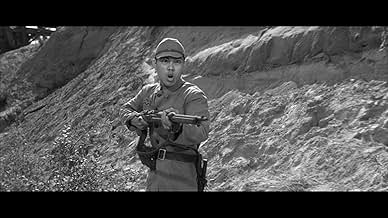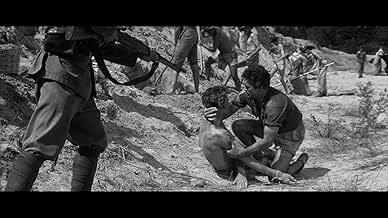अपनी भाषा में प्लॉट जोड़ेंDeep in Malaya, as World War II is rapidly coming to an end, men, women and children, trapped by the Japanese invasion, are held captive in the Blood Island prison camp. Knowing that Yamamit... सभी पढ़ेंDeep in Malaya, as World War II is rapidly coming to an end, men, women and children, trapped by the Japanese invasion, are held captive in the Blood Island prison camp. Knowing that Yamamitsu, the sadistic commandant, will murder them all when he learns of his country's defeat, ... सभी पढ़ेंDeep in Malaya, as World War II is rapidly coming to an end, men, women and children, trapped by the Japanese invasion, are held captive in the Blood Island prison camp. Knowing that Yamamitsu, the sadistic commandant, will murder them all when he learns of his country's defeat, Dutch, a Dutch planter, smashes the camp radio. British officer Lambert and, in the women'... सभी पढ़ें
- Lambert
- (as Andre Morell)
- 'Dutch'
- (as Carl Mohner)
फ़ीचर्ड समीक्षाएं
It was Guest who, with his international hit «The Quatermass Xperiment» (1955), pointed Hammer on the profitable path of "cinéma fantastique." However, apart from this film and its sequel «Quatermass 2,» Guest did not return to horror, not even when he made «The Abominable Snowman,» a good drama that he kept on a more philosophical and mystical plane, away from frights.
Before finding a more viable breakthrough to mainstream cinema with «Expresso Bongo» (1959), produced by his own company, Guest made for Hammer psychological dramas, thrillers and the war diptych consisting of «The Camp on Bloody Island» (1958) and «Yesterday's Enemy» (1959), a kind of war claim made to Japan, through cinema.
«The Camp on Bloody Island» was a box office success that consolidated the distribution of Hammer products through the American company Columbia Pictures; which addressed, 13 years after the end of World War II, the mistreatment received by British prisoners of war in a Japanese prison, located in the fictional Blood Island, on the former British colony of Malaysia. By then Columbia was preparing the release of a movie with a similar theme, «The Bridge on the River Kwai» by David Lean, which garnered attention and awards, but this did not prevent the Hammer production, despite devastating criticism, from being a hit. «The Camp on Bloody Island» was bolstered by the best-selling novelization of the script by John Manchip White and Guest.
Inspired by real events, the film of course took the "Hammer-style" way, with scenes of violence and sensational effects to impress the audience, and a little bit of eroticism. Of both films, this is the most dynamic, with the action taking place in two main locations, a prison for British soldiers and a diplomat, and another for women; but from the dramatic point of view, it is the weakest. The script delineates the characters with a few strokes and all the credibility falls on the actors' backs.
In the case of the British, the balance is fortunate, in particular, with the work of André Morell, as the leader of the prisoners, who tries to hide information from the Japanese, boycotting their communication system, to stay alive. However, for the Japanese roles... Hammer did whatever it took to achieve its purpose, including casting the magnificent Indian character actor Marne Maitland as a Japanese villain. Of course, Maitland, as always, is the most wicked villain, with a squeaky little voice, which makes him meaner. I could not help but smile at the sight of dear old Marne, who I have seen in so many movies, squinting his eyes!
These two small, low-budget and effective films, in addition to the remarkable films that I knew and mentioned at the beginning of these notes, have increased the esteem that I already had for Val Guest's work.
G.G.
There is some fine acting on display, both from the actors playing the Japanese, who convey a sense of alien culture without becoming ridiculous, and those portraying the physically drained and starving prisoners: the opening shots of the young man struggling to dig his own grave are actively disturbing, both for his apparent emaciation and for his dragging movements of utter collapse. Andre Morell, of course, dominates the film as the obstinate and authoritarian Colonel Lambert, and in a sense the plot structure consists of gradually justifying his seemingly unreasonable behaviour -- but it is not that simplistic, and the revelation of the final consequences of his decisions (was it, ultimately, all unnecessary?) leaves a note of deliberate ambiguity.
The prisoners in the women's camp are, perhaps inevitably, shown as rather more glamorous than their male counterparts, with their fetching dishevelment a token gesture towards the starvation and illness stated in the script. Barbara Shelley, playing Kate, does appear rather too healthy in her close-ups for the degree of weakness and collapse she is supposed to portray during her escape. But unsurprisingly this is a male-dominated film, and all the really intriguing characters are male. Lambert himself, and the fretful diplomat Beattie, chafing under what he sees as the military mishandling of their situation. Father Paul, jeopardising his life and his cloth to pass messages via the medium of the funeral Mass. The former planter Van Elst, driven to repeated risky sabotage.
For a film that was condemned on release for its 'orgy of atrocities', "The Camp on Blood Island" is actually quite restrained in what is implied, let alone shown on screen: the horrors and Japanese 'bestiality' are as much psychological, based on petty humiliation and anticipation, as anything else. This is not torture porn -- the worst that we see is machine-gunning, plus one clean beheading. ("Bridge on the River Kwai" actually goes further in this respect.) But there is never any doubt that the prisoners' situation is horrific, and that ultimately they are prepared to throw lives away in a desperate attempt at group survival.
क्या आपको पता है
- ट्रिवियाThe novelization of the screenplay was a spectacular success, selling up to two million copies.
- गूफ़As in most war films, the time between the pulling the pin on the grenades and its detonations are wrong (it's happening sooner). There are roughly twenty seconds in-between. It is, however, wrong to assume that the arming process begins as the pin ("Transport Safety") is removed: The Fuse is activated as the grenade is released by the hand ("Arming Safety"), either dropped or thrown, so the time between pulling the pin and the grenade detonating can vary considerably.
- भाव
Col. Lambert: I've no use for shirkers and there's no room for self-pity here.
- क्रेज़ी क्रेडिट"This is not just a story - it is based on a brutal truth."
- कनेक्शनFeatured in The World of Hammer: Hammer (1994)
टॉप पसंद
- How long is The Camp on Blood Island?Alexa द्वारा संचालित
विवरण
- रिलीज़ की तारीख़
- कंट्री ऑफ़ ओरिजिन
- भाषाएं
- इस रूप में भी जाना जाता है
- Die gelbe Hölle
- फ़िल्माने की जगहें
- Callow Hill Sandpit, Virginia Water, सरी, इंग्लैंड, यूनाइटेड किंगडम(mining sequences)
- उत्पादन कंपनी
- IMDbPro पर और कंपनी क्रेडिट देखें
- चलने की अवधि1 घंटा 22 मिनट
- रंग
- पक्ष अनुपात
- 2.35 : 1
इस पेज में योगदान दें



































